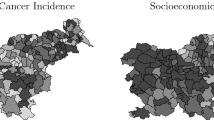Abstract
The distributional transform (DT) is amongst the computational methods used for estimation of high-dimensional multivariate normal copula models with discrete responses. Its advantage is that the likelihood can be derived conveniently under the theory for copula models with continuous margins, but there has not been a clear analysis of the adequacy of this method. We investigate the small-sample and asymptotic efficiency of the method for estimating high-dimensional multivariate normal copula models with univariate Bernoulli, Poisson, and negative binomial margins, and show that the DT approximation leads to biased estimates when there is more discretization. For a high-dimensional discrete response, we implement a maximum simulated likelihood method, which is based on evaluating the multidimensional integrals of the likelihood with randomized quasi Monte Carlo methods. Efficiency calculations show that our method is nearly as efficient as maximum likelihood for fully specified high-dimensional multivariate normal copula models. Both methods are illustrated with spatially aggregated count data sets, and it is shown that there is a substantial gain on efficiency via the maximum simulated likelihood method.



Similar content being viewed by others
References
Aitchinson J, Ho C (1989) The multivariate poisson-log normal distribution. Biometrika 75:621–629
Banerjee S, Carlin BP, Gelfand AE (2014) Hierarchical modeling and analysis for spatial data. Chapman & Hall, London
Cameron AC, Trivedi PK (1998) Regression analysis of count data. Cambridge University Press, Cambridge
Denuit M, Lambert P (2005) Constraints on concordance measures in bivariate discrete data. J Multivar Anal 93(1):40–57
Diggle P, Ribeiro PJ (2007) Model-based geostatistics. Springer, New York
Diggle PJ, Tawn JA, Moyeed RA (1998) Model-based geostatistics. J R Stat Soc 47(3):299–350
Ferguson TS (1967) Mathematical statistics: a decision theoretic approach. Probability and mathematical statistics. Academic Press, New York
Gelfand AE, Vounatsou P (2003) Proper multivariate conditional autoregressive models for spatial data analysis. Biostatistics 4(1):11–15
Genz A (1992) Numerical computation of the multivariate normal probabilities. J Comput Graph Stat 1:141–150
Genz A, Bretz F (2002) Methods for the computation of the multivariate \(t\)-probabilities. J Comput Graph Stat 11:950–971
Genz A, Bretz F (2009) Computation of multivariate normal and \(t\) probabilities. Springer, New York
Genz, A., Bretz, F., Miwa, T., Mi, X., Leisch, F., Scheipl, F., and Hothorn, T. (2012). mvtnorm: Multivariate Normal and t Distributions. R package version 0.9-9992
Hodges J (2013) Richly parameterized linear models: additive, time series, and spatial models using random effects. Chapman & Hall, London
Hughes, J. (2014). copCAR: A flexible regression model for areal data. J Comput Graph Stat. http://dx.doi.org/10.1080/10618600.2014.948178
Joe H (1997) Multivariate models and dependence concepts. Chapman & Hall, London
Joe H (2014) Dependence modeling with copulas. Chapman & Hall, London
Johnson NL, Kotz S (1972) Continuous multivariate distributions. Wiley, New York
Kazianka H (2013) Approximate copula-based estimation and prediction of discrete spatial data. Stoch Environ Res Risk Assess 27(8):2015–2026
Kazianka H, Pilz J (2010) Copula-based geostatistical modeling of continuous and discrete data including covariates. Stoch Environ Res Risk Assess 24(5):661–673
Lawless JF (1987) Negative binomial and mixed poisson regression. Can J Stat 15(3):209–225
Madsen L (2009) Maximum likelihood estimation of regression parameters with spatially dependent discrete data. J Agric Biol Environ Stat 14:375–391
Madsen L, Fang Y (2011) Joint regression analysis for discrete longitudinal data. Biometrics 67:1171–1175
Mardia KV (1988) Multi-dimensional multivariate gaussian markov random fields with application to image processing. J Multivar Anal 24(2):265–284
Nash J (1990). Compact numerical methods for computers: linear algebra and function minimisation. Hilger, New York. 2nd edition
Nelsen RB (2006) An introduction to copulas. Springer, New York
Nikoloulopoulos, A. K. (2013a). Copula-based models for multivariate discrete response data. In Durante, F., Härdle, W., and Jaworski, P., editors, Copulae in Mathematical and Quantitative Finance, Springer, New York, p 231–249
Nikoloulopoulos AK (2013b) On the estimation of normal copula discrete regression models using the continuous extension and simulated likelihood. J Stat Plan Inference 143:1923–1937
Nikoloulopoulos AK, Joe H (2013) Factor copula models for item response data. Psychometrika. http://dx.doi.org/10.1007/s11336-013-9387-4
Nikoloulopoulos AK, Joe H, Chaganty NR (2011) Weighted scores method for regression models with dependent data. Biostatistics 12:653–665
Rüschendorf L (1981) Stochastically ordered distributions and monotonicity of the oc-function of sequential probability ratio tests. Ser Stat 12(3):327–338
Rüschendorf L (2009) On the distributional transform, sklar’s theorem, and the empirical copula process. J Stat Plan Inference 139(11):3921–3927
Serfling RJ (1980) Approximation theorems of mathematical statistics. Wiley, New York
Shi P, Valdez EA (2014a) Longitudinal modeling of insurance claim counts using jitters. Scand Actuar J 2014(2):159–179
Shi P, Valdez EA (2014b) Multivariate negative binomial models for insurance claim counts. Insurance 55:18–29
Sklar M (1959) Fonctions de répartition à \(n\) dimensions et leurs marges. Publications de l’Institut de Statistique de l’Université de Paris 8:229–231
Song PX-K (2007) Correlated data analysis: modeling, analytics, and application. Springer, New York
Varin C (2008) On composite marginal likelihoods. Adv Stat Anal 92:1–28
Varin C, Reid N, Firth D (2011) An overview of composite likelihood methods. Stat Sin 21:5–42
Xia H, Carlin BP (1998) Spatio-temporal models with errors in covariates: mapping Ohio lung cancer mortality. Stat Med 17(18):2025–2043
Zadnik V, Reich B (2006) Analysis of the relationship between socioeconomic factors and stomach cancer incidence in slovenia. Neoplasma 53(2):103–110
Zhao Y, Joe H (2005) Composite likelihood estimation in multivariate data analysis. Can J Stat 33(3):335–356
Author information
Authors and Affiliations
Corresponding author
Rights and permissions
About this article
Cite this article
Nikoloulopoulos, A.K. Efficient estimation of high-dimensional multivariate normal copula models with discrete spatial responses. Stoch Environ Res Risk Assess 30, 493–505 (2016). https://doi.org/10.1007/s00477-015-1060-2
Published:
Issue Date:
DOI: https://doi.org/10.1007/s00477-015-1060-2




